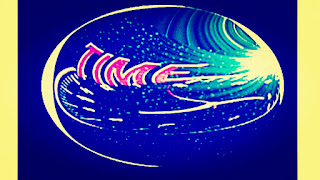Does time flow in one direction? Does time have only a positive value? Does time have a negative value of the dimension?
 |
| Space-Time Illustration |
Think of the way you could tell time without a clock or a watch. You could probably use your shadow or look at the stars in the night sky or maybe you could listen to the crowing rooster.
Imagine time as an entity that has dimensions in which everything exists. It's an important question that awakens the imagination to think of something that events do happen surrounding the concept of existence.
Does time have a beginning? Aristotle proposed that for time to have a beginning, the first moment would have to come between one period and a later period and time has no end.
The universe exists in multiple dimensions all measured by space and time . The first dimension is length and the universe appears as a line. Secondly, the dimensions of width make it a plane, and the third dimensions are height and the universe exists as we perceive it now.
The physical change is measured by the temporal dimension or fourth dimension which is a time dimension. Facts and information are existence in a temporality of time.
Direction Details of Time.
- The hand (ticker) of a clock often moves in one direction (clockwise). Accordingly, in the northern hemisphere, the path of the shadow from a timer or ticker over a day comes after a path from left to right. The astonishing trend is headed by the observable path of the sun in our hemisphere, rising in the east and setting in the west.
- The time before an event is considered a negative time, whereas else time after the event is a positive time. And that is why we can't see the future but the past. "Entropy (disorder or uncertainty) increases as time flows toward the future." The second law of thermodynamics.
- The microscopic illustration of nature in analytical physics does not show symmetry under time retraction.
- Time can have multiple streams of moments related and isolated to each other, time has the quality of open future infinity continuation.
Time exists because the universe is expanding. Without expansion, time has no meaning. The universe exists as a singularity, infinitely small as infinitely large. It's a point or region of infinite mass density at which space and time are infinitely deformed by gravitational forces and which is maintained to be the final form of matter collapsing into a black hole.
We often think of singularity where all matter is concentrated into a particle like a speck or a dot. Without time or space, size has no meaning. Thus eternity has none either, it is timeless. The cosmos is not fixed or limited by time or space. It exists in all proportions and sizes, simultaneously.
It's mind-boggling how objects exist in time without being present. The thing that exists outside of time is abstract. As time moves things exist temporarily. Some existing things are in the same vicinity of space and time that we found ourselves right now, while some are not.
We measure time according to our existence. The universe measures time according to its expansion. Nature in our control measures time and views it as a valuable commodity, while nature beyond our control doesn't measure the value of time at all, but existence. Humans first try to record or explain how we came into existence using time as we understand it to describe it as natural existence.
Our understanding of time is less than adequate for describing the eons ( long periods) that take hours and days. A single day on Mars or Jupiter is far longer than that on Earth. Also, the galactic year can't be the same as a universal year. Yet, a light year is the distance between stars with the perspective of time in terms of a year.
Dynamic and atomic time try to measure and calculate time. Atomic time does it more accurately. Atomic time depends on energy transition within the atom of a certain element cesium. Hence, a number of transitions are used to measure time without losing a tiny portion of a second in a million years. A second is defined as 9,192,631,770 transitions within a cesium atom.
One spherical entity revolving around another spherical entity that's how we perceive and measure time. Time has a change in characteristics. Events do change time that's to say present evolved and revolves around the past, and the future is an uncertain aspect of time according to change. Hence, the reality is now. The future lingers between reality and imagination.
From scientific, and philosophical to ancestral points of view of time, we revolve and evolve relatively to time. Days and years, for example, are explained by the perspective of 360⁰ of a sphere per 24 hours for each time zone of 15⁰, which equals 4 minutes.
The light is less blocked when the sun is high in the sky. Therefore, the position of the sun affects the size of the shadow as it moves.
We can tell time with the shadow from a post or a rod and the motion of objects across space. The shortest point at which the shadow comes down is noontime. The distance and direction dimensions affect how we perceive and tell time.
References
Mirman, R. The direction of time. Found Phys 5, 491–511 (1975). https://doi.org/10.1007/BF00708892
Emery, Nina, Ned Markosian, and Meghan Sullivan, "Time", The Stanford Encyclopedia of Philosophy (Winter 2020 Edition), Edward N. Zalta (ed.), URL = https://plato.stanford.edu/archives/win2020/entries/time/
Time, How it Works. https://www.space.com/time-how-it-works



Thank you for reading!